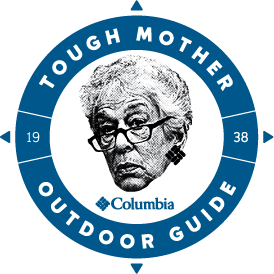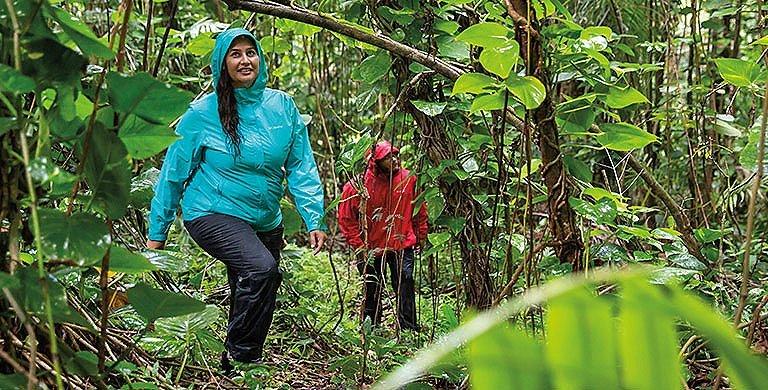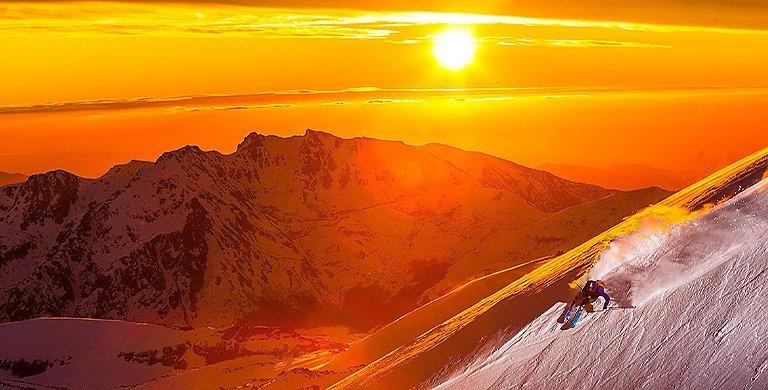EXPLORATION
The Best National Parks to Visit in the Winter
Winter is an incredible time to see America’s national parks—here’s everything you need to know to plan a visit
BY RACHEL CAVANAUGH
National parks are magical in the wintertime—snow blankets the ground and pristine landscapes unfold before you. Animals go about their business quietly, gathering food and enjoying their newfound solitude with the dwindling number of visitors. Winter-specific activities such as snowshoeing, cross-country skiing, snowmobiling, and ice skating abound, replacing the standard hiking and backpacking. It’s a wonderful time to visit a historic lodge or rent a winter cabin. There is even free admission on Martin Luther King Jr. Day, providing a great excuse for a winter excursion.
To help you discover some of the best national parks to visit in winter, we’ve put together an easy guide below, complete with cold-weather travel tips.
To help you discover some of the best national parks to visit in winter, we’ve put together an easy guide below, complete with cold-weather travel tips.
How to Visit National Parks in the Winter
Many national parks remain at least partially open in the winter. However, access may be limited in some areas—roads may be closed (especially in December, January, February, March, and April) and certain trails may be restricted. Additionally, you’ll need to bring warm clothes and pay extra attention to your gear. Winter is a great time to explore the parks, but requires a bit of extra planning in advance to make sure your trip is safe and fun.
Before you start planning which park to visit, read these tips to help make your trip more successful.
Before you start planning which park to visit, read these tips to help make your trip more successful.
- Check on closures: Before you go, visit the park’s official website to get specific information on which trails will be open, what roads are closed, and if there are any recommended detours. It’s also smart to make note of the road conditions and check for any hazards or safety alerts. If you’re visiting a park where snow or ice will be present, travel in a reliable vehicle, preferably with 4WD, or consider taking a winter-equipped RV. (For more information on RV travel, check out 6 Tips for RV Camping in National Parks.)
- Watch the weather: It’s always important to be mindful of the weather, but when you’re traveling in the winter months it’s extra critical. Keep in mind that weather conditions can vary dramatically from location to location, especially in larger parks, so note the specific area you’ll be visiting. In parks with varied elevations, for example, you might find clear skies in one section while another area experiences a full-blown winter storm. Conditions can also change rapidly within one afternoon, so be sure to monitor the weather throughout the day. The National Oceanic and Atmospheric Administration (NOAA) is a great resource for tracking weather alerts.
- Bring the right gear: When visiting national parks in the wintertime, it’s imperative to bring warm winter clothes and know how to layer for cold weather. Additionally, the National Parks Service recommends traveling with ample emergency gear. Even if you don’t plan to stay overnight, you should carry sleeping provisions, as well as extra food, water, and safety equipment, including a first aid kit, flashlight, whistle, and a knife. (For tips on how to bundle up, check out our guide to Staying Warm in Cold Weather.)
- Know your limits: Weather elements such as snow and ice can make hiking trails more difficult to navigate in the wintertime. Even walking paths and simple viewing areas can become slippery this time of year, so take extra precautions. It’s advisable to avoid hiking alone in the winter, and always have an emergency contact who knows where you are. For extra assistance, use the NPS Trip Planning Guide to help ensure your visit goes smoothly.
Columbia Sportswear is proud to support the National Park Foundation to help protect and preserve our most treasured places, keeping them ready for your adventures now and for years to come.
The Best National Parks to Visit in Winter
Yosemite National Park - California
In addition to winter-specific activities such as sledding, ice skating, skiing, and snowshoeing, Yosemite National Park offers stunning views of frosty, ice-covered waterfalls and picturesque frozen streams. The main Tioga Road is typically closed; however, Glacier Point-Badger Pass Road usually remains open and snowplows keep it maintained so that snowshoers can take full advantage of it.
For up-to-date info, check out Yosemite National Park’s website.
For up-to-date info, check out Yosemite National Park’s website.
Acadia National Park - Maine
During the months of December, January, and February, the beautiful Acadia National Park in Maine morphs into a winter wonderland, making it ideal for activities such as snowshoeing and cross-country skiing. It boasts 45 miles of scenic carriage roads, along with a sprawling, stunning coastline. Most of Park Loop Road closes; however, the sections around Ocean Drive and Jordan Pond Road usually remain open. Just keep in mind that temperatures linger around 32 degrees Fahrenheit, so make sure to pack the warmest winter jacket you can find.
For up-to-date info, check out Acadia National Park’s website.
For up-to-date info, check out Acadia National Park’s website.
Grand Canyon National Park - Arizona
The Grand Canyon is always a spectacular sight, but it tends to get overrun by tourists in the summertime. In winter, by contrast, the park is similarly splendid, but it only receives a fraction of the visitors. In addition to the extra space, winter adventurers will be treated to glimpses of canyon walls that are covered in frost, giving it an ethereal glow. Just note that the North Rim is typically closed in the winter months.
For up-to-date info, check out Grand Canyon National Park’s website.
For up-to-date info, check out Grand Canyon National Park’s website.
Yellowstone National Park - Wyoming, Montana, and Idaho
Yellowstone National Park is one of the best national parks to visit during the winter months. It offers activities like snowshoeing, snowmobiling, and cross-country skiing, as well as snow coach tours and winter photography safaris. Best of all, visitors can take guided trips to see Old Faithful and other geysers with snow and frost in the background.
For up-to-date info, check out Yellowstone National Park’s website.
For up-to-date info, check out Yellowstone National Park’s website.
Volcanoes National Park - Hawaii
On top of the perk of having fewer tourists, one of the advantages of visiting Volcanoes National Park in the winter months (December through March), is that the humidity tends to be lower. The park still boasts the same stunning volcanoes and intriguing lava tubes, but it doesn’t feel as sticky and there’s more room to move around.
For up-to-date info, check out Volcanoes National Park’s website.
For up-to-date info, check out Volcanoes National Park’s website.
Zion National Park - Utah
For Utah travelers, a winter trip to Zion National Park satisfies the thirst for adventure while offering breathtaking desert views. The beautiful Zion Canyon Scenic Drive, which is usually closed in the summertime, opens up this time of year, and the area between the East Rim Trail and Observation Point is accessible for snowshoeing and cross-country skiing. Not only that, winter vacationers will avoid the intense heat that often accompanies the summer months.
For up-to-date info, check out Zion National Park’s website.
For up-to-date info, check out Zion National Park’s website.
Everglades National Park - Florida
Everglades National Park never ceases to amaze whether it’s spring, summer, fall, or winter. From November to April, the park experiences its dry season where temperatures hover around 77 degrees Fahrenheit. Most of the pesky insects such as mosquitos or flies (which can be major nuisances in the summertime) all but disappear this time of year. Not only that, the birding and wildlife viewing tends to be better as animals congregate around receding water holes.
For up-to-date info, check out Everglades National Park’s website.
For up-to-date info, check out Everglades National Park’s website.
Mount Rainier National Park - Washington
When it comes to winter wonderlands in the Pacific Northwest, it’s hard to beat Mount Rainier National Park. The beautiful white-capped oasis features gorgeous mountain ranges that offer stunning opportunities for snowshoeing, snowmobiling, Paradise area sledding, skiing, snowboarding, and winter camping. And while some sections of the park are typically closed due to heavy snowfall, the Longmire area boasts an entire network of trails dedicated to winter fun.
For up-to-date info, check out Mount Rainier National Park’s website.
For up-to-date info, check out Mount Rainier National Park’s website.
Big Bend National Park - Texas
If you love sprawling desert landscapes and rugged rock formations, Big Bend National Park is the spot for you. In the wintertime, it has fewer visitors, which lends it a stillness that’s hard to match, especially in the evenings. The park also boasts some of the starriest skies in the contiguous U.S. Visitors can take night tours to gaze at the Milky Way and there are also daytime activities such as jeep and ATV tours.
For up-to-date info, check out Big Bend National Park’s website.
For up-to-date info, check out Big Bend National Park’s website.
Great Smoky Mountains National Park - North Carolina and Tennessee
Another fantastic option for wintertime exploration is Great Smoky Mountains National Park. Located on the border between North Carolina and Tennessee, the park showcases spectacular mountain ranges yet it remains relatively warm compared to places like the Rockies or the Pacific Northwest. The scenery is beautiful and there are tons of things to do, including hiking along frost-covered creeks and viewing ice formations along the waterfalls.
For up-to-date info, check out Great Smoky Mountains National Park’s website.
For up-to-date info, check out Great Smoky Mountains National Park’s website.
Need some gear for your winter adventures? Check out Columbia Sportswear's cold-weather apparel.
For more national parks guides check out Columbia Sportswear's guides for the best national parks to visit in spring, summer, and fall.
For more national parks guides check out Columbia Sportswear's guides for the best national parks to visit in spring, summer, and fall.



?scl=1)